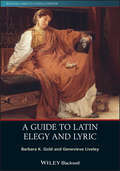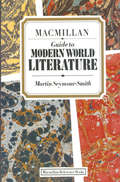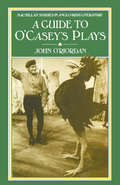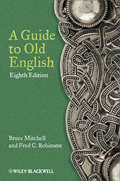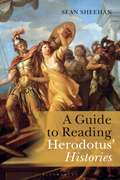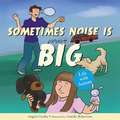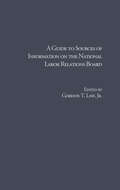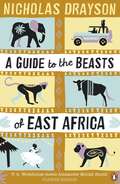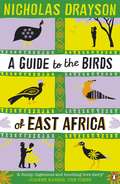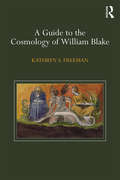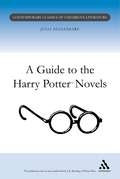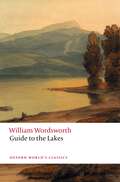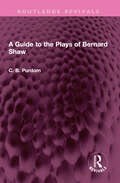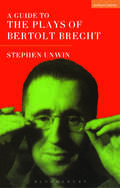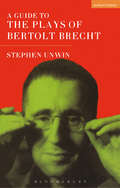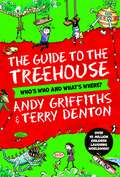- Table View
- List View
A Guide to Latin Elegy and Lyric (Blackwell Guides to Classical Literature)
by Barbara K. Gold Genevieve LiveleyProvides the necessary context to read elegiac and lyric poetry, designed for novice and experienced Classics and Latin students alike A Guide to Latin Elegy and Lyric explores the language of Latin poetry while helping readers understand the socio-cultural context of the remarkable period of Roman literary history in which the poetry was composed. With an innovative approach to this important area of classical scholarship, the authors treat elegy alongside lyric as they cover topics such as the Hellenistic influences on Augustan poetry, the key figures that shaped the elegiac tradition of Rome, the motifs of militia amoris (“the warfare of love”) and servitium amoris (“the slavery of love”) in Latin love elegy, and more. Organized into ten chapters, the book begins with an introduction to the literary, political, and social contexts of the Augustan Age. The next six chapters each focus on an individual lyric and elegiac poet—Catullus, Horace, Tibullus, Propertius, Ovid, and Sulpicia—followed by a survey of several lesser-known poets and post-Augustan elegy and lyric. The text concludes with a discussion of major tropes and themes in Latin elegy and lyric, and an overview and analysis of key critical approaches in current scholarship. This volume: Includes full translations alongside the Latin throughout the text to illustrate discussions Analyzes recurring themes and tropes found in Latin poetry such as sexuality and gender, politics and patronage, myth and religion, wealth and poverty, empire, madness, magic, and witchcraft Reviews modern critical approaches to elegiac and lyric poetry including autobiographical realism, psychoanalysis, narratology, reception, and decolonization Includes helpful introductory sections: “How to Read a Latin Elegiac or Lyric Poem” and “How to Teach a Latin Elegiac and Lyric Poem” Provides information about each poet, an in-depth discussion of some of their poetry, and cultural and historical background Features a dedicated chapter on Sulpicia, offering readers an ancient female viewpoint on sex and gender, politics, and patronage Part of the acclaimed Blackwell Guides to Classical Literature series, A Guide to Latin Elegy and Lyric is the perfect text for both introductory and advanced courses in Latin elegy and lyric, accessible for students reading the poetry in translation, as well as for those experienced in Latin with an interest in learning a different approach to the subject.
A Guide to Latin Elegy and Lyric (Blackwell Guides to Classical Literature)
by Barbara K. Gold Genevieve LiveleyProvides the necessary context to read elegiac and lyric poetry, designed for novice and experienced Classics and Latin students alike A Guide to Latin Elegy and Lyric explores the language of Latin poetry while helping readers understand the socio-cultural context of the remarkable period of Roman literary history in which the poetry was composed. With an innovative approach to this important area of classical scholarship, the authors treat elegy alongside lyric as they cover topics such as the Hellenistic influences on Augustan poetry, the key figures that shaped the elegiac tradition of Rome, the motifs of militia amoris ("the warfare of love") and servitium amoris (“the slavery of love”) in Latin love elegy, and more. Organized into ten chapters, the book begins with an introduction to the literary, political, and social contexts of the Augustan Age. The next six chapters each focus on an individual lyric and elegiac poet—Catullus, Horace, Tibullus, Propertius, Ovid, and Sulpicia—followed by a survey of several lesser-known poets and post-Augustan elegy and lyric. The text concludes with a discussion of major tropes and themes in Latin elegy and lyric, and an overview and analysis of key critical approaches in current scholarship. This volume: Includes full translations alongside the Latin throughout the text to illustrate discussions Analyzes recurring themes and tropes found in Latin poetry such as sexuality and gender, politics and patronage, myth and religion, wealth and poverty, empire, madness, magic, and witchcraft Reviews modern critical approaches to elegiac and lyric poetry including autobiographical realism, psychoanalysis, narratology, reception, and decolonization Includes helpful introductory sections: "How to Read a Latin Elegiac or Lyric Poem" and "How to Teach a Latin Elegiac and Lyric Poem" Provides information about each poet, an in-depth discussion of some of their poetry, and cultural and historical background Features a dedicated chapter on Sulpicia, offering readers an ancient female viewpoint on sex and gender, politics, and patronage Part of the acclaimed Blackwell Guides to Classical Literature series, A Guide to Latin Elegy and Lyric is the perfect text for both introductory and advanced courses in Latin elegy and lyric, accessible for students reading the poetry in translation, as well as for those experienced in Latin with an interest in learning a different approach to the subject.
Guide to Life and Literature of the Southwest
by Frank DobieA compilation of South-Western literature.
Guide to O'Casey's Plays: From The Plough To The Stars (Macmillan Studies in Anglo-Irish Literature)
by John O'RiordanA Guide to Old English: Revised With Texts And Glossary (Heritage Ser.)
by Bruce Mitchell Fred C. RobinsonA comprehensive introduction to Old English, combining simple, clear philology with the best literary works to provide a compelling and accessible beginners’ guide. Provides a comprehensive introduction to Old English Uses a practical approach suited to the needs of the beginning student Features selections from the greatest works of Old English literature, organized from simple to more challenging texts to keep pace with the reader Includes a discussion of Anglo-Saxon literature, history, and culture, and a bibliography directing readers to useful publications on the subject Updated throughout with new material including the first 25 lines from Beowulf with detailed annotation and an explanation of Grimm’s and Verner’s laws
A Guide to Old English
by Bruce Mitchell Fred C. RobinsonA comprehensive introduction to Old English, combining simple, clear philology with the best literary works to provide a compelling and accessible beginners’ guide. Provides a comprehensive introduction to Old English Uses a practical approach suited to the needs of the beginning student Features selections from the greatest works of Old English literature, organized from simple to more challenging texts to keep pace with the reader Includes a discussion of Anglo-Saxon literature, history, and culture, and a bibliography directing readers to useful publications on the subject Updated throughout with new material including the first 25 lines from Beowulf with detailed annotation and an explanation of Grimm’s and Verner’s laws
A Guide to Reading Herodotus' Histories
by Sean SheehanModern scholarship judges Herodotus to be a more complex writer than his past readers supposed. His Histories is now being read in ways that are seemingly incompatible if not contradictory. This volume interrogates the various ways the text of the Histories has been and can be read by scholars: as the seminal text of our Ur-historian, as ethnology, literary art and fable. Our readings can bring out various guises of Herodotus himself: an author with the eye of a travel writer and the mind of an investigative journalist; a globalist, enlightened but superstitious; a rambling storyteller but a prose stylist; the so-called 'father of history' but in antiquity also labelled the 'father of lies'; both geographer and gossipmonger; both entertainer and an author whom social and cultural historians read and admire.Guiding students chapter-by-chapter through approaches as fascinating and often surprising as the original itself, Sean Sheehan goes beyond conventional Herodotus introductions and instead looks at the various interpretations of the work, which themselves shed light on the original. With text boxes highlighting key topics and indices of passages, this volume is an essential guide for students whether reading Herodotus for the first time, or returning to revisit this crucial text for later research.
A Guide to Reading Herodotus' Histories
by Sean SheehanModern scholarship judges Herodotus to be a more complex writer than his past readers supposed. His Histories is now being read in ways that are seemingly incompatible if not contradictory. This volume interrogates the various ways the text of the Histories has been and can be read by scholars: as the seminal text of our Ur-historian, as ethnology, literary art and fable. Our readings can bring out various guises of Herodotus himself: an author with the eye of a travel writer and the mind of an investigative journalist; a globalist, enlightened but superstitious; a rambling storyteller but a prose stylist; the so-called 'father of history' but in antiquity also labelled the 'father of lies'; both geographer and gossipmonger; both entertainer and an author whom social and cultural historians read and admire.Guiding students chapter-by-chapter through approaches as fascinating and often surprising as the original itself, Sean Sheehan goes beyond conventional Herodotus introductions and instead looks at the various interpretations of the work, which themselves shed light on the original. With text boxes highlighting key topics and indices of passages, this volume is an essential guide for students whether reading Herodotus for the first time, or returning to revisit this crucial text for later research.
A Guide to Sometimes Noise is Big for Parents and Educators (PDF)
by Angela Coelho Camille RobertsonSometimes noise is too big for my ears. Sometimes the light is too loud for my eyes. I have autism and this means that sometimes the world around me is just too much! This book will help you to see the world through my eyes and to understand why I react to things the way I do. Flipping the perspective for neurotypicals, this book explains in simple terms some of the sensory issues experienced by children with autism. It shows situations which can be overwhelming and the ways that somebody with autism might react when there is too much going on. This picture book raises awareness of autism and helps young children of all abilities to better understand these issues. Suitable for ages 5+.
A Guide to Sources of Information on the National Labor Relations Board (Research and Information Guides in Business, Industry and Economic Institutions)
by Gordon T. Law M. P. CatherwoodA concise history of the board in the U.S. from its inception in 1935, including an overview of current case law, and a bibliographic essay of selected secondary literature about the board.
A Guide to Sources of Information on the National Labor Relations Board (Research and Information Guides in Business, Industry and Economic Institutions)
by Gordon T. Law Jr.A concise history of the board in the U.S. from its inception in 1935, including an overview of current case law, and a bibliographic essay of selected secondary literature about the board.
A Guide to the Beasts of East Africa
by Nicholas DraysonFor lovers of Alexander McCall Smith, the engaging follow up to Nicholas Drayson's much-loved A Guide to the Birds of East Africa sees the return of Mr Malik and the East African Ornithological Society.Mr Malik has been busy planning the Asadi Club's annual safari. But a series of crimes puts the club's very existence at risk. It is up to Mr Malik and Co. to solve a decades-old murder, recover the club mascot and identify, once and for all, the most dangerous beast in Africa.Not to mention his only daughter may, or may not, be getting married in a week.Will Mr Malik again prevail over Kenyan politics, a reluctant bride and unrevealed secrets?'A book of immense charm; a sort of P G Wodehouse meets Alexander McCall Smith' Joanne Harris on A Guide to the Birds of East Africa'A delightful comedy... It invites comparison to The No.1 Ladies' Detective Agency books, but it's original and, if anything, has more depth' Daily Mail on A Guide to the Birds of East AfricaNicholas Drayson was born in England and lived in Australia since 1982, where he studied zoology and gained a PhD in 19th-century Australian natural history writing and two daughters. He has worked as a journalist in the UK, Kenya and Australia, writing for publications such as the Daily Telegraph and Australian Geographic. He is the author of three previous novels, Confessing a Murder, Love and the Platypus and A Guide to the Birds of East Africa (Penguin, 2008). He is now wandering through England aboard his boat, the Summer Breeze.
A Guide to the Birds of East Africa: A Novel
by Nicholas DraysonFor lovers of Alexander McCall Smith, Nicholas Drayson introduces the charming Mr Malik and the East African Ornithological Society in A Guide to the Birds of East Africa.Reserved, honourable Mr Malik. You wouldn't notice him in a Nairobi street - except, perhaps, to comment on his carefully sculpted comb-over - but beneath his unprepossessing exterior lie a warm heart and a secret passion. Not even his closest friends know it, but Mr Malik is head-over-heels in love with the leader of the local Tuesday-morning bird walk, Rose Mbikwa.Little can he imagine the hurdles that lie before him. Even as he plucks up the courage to ask for Rose's hand, thieves, potential kidnappers and corrupt officials, not to mention one particularly determined love rival, seem destined to thwart Mr Malik's chances.Will an Indian gentleman in the heart of Africa be defeated by the many obstacles that stand between him and his heart's desire? Or will honour and decency prevail?'A funny, ingenious and touching love story' Joanne Harris, The Times'A delightful comedy... It invites comparison to The No.1 Ladies' Detective A gency books, but it's original and, if anything, has more depth' Daily Mail'Sweet, charming and utterly wonderful on the subject of birds' MetroNicholas Drayson was born in England and has lived in Australia since 1982, where he studied zoology and a PhD in 19th century Australian natural history writing. He has worked as a journalist in the UK, Kenya and Australia, writing for publications such as the Daily Telegraph and Australian Geographic. He is the author of three other novels, Confessing a Murder, Love and the Platypus and A Guide to the Beasts of East Africa.
A Guide to the Cosmology of William Blake
by Kathryn S. FreemanIt is not surprising that visitors to Blake’s cosmology – the most elaborate in the history of British text and design – often demand a map in the form of a reference book. The entries in this volume benefit from the wide range of historical information made available in recent decades regarding the relationship between Blake’s text and design and his biographical, political, social, and religious contexts. Of particular importance, the entries take account of the re-interpretations of Blake with respect to race, gender, and empire in scholarship influenced by the groundbreaking theories that have arisen since the first half of the twentieth century. The intricate fluidity of Blake’s anti-Newtonian universe eludes the fixity of definitions and schema. Central to this guide to Blake's work and ideas is Kathryn S. Freeman's acknowledgment of the paradox of providing orientation in Blake’s universe without disrupting its inherent disorientation of the traditions whereby readers still come to it. In this innovative work, Freeman aligns herself with Blake’s demand that we play an active role in challenging our own readerly habits of passivity as we experience his created and corporeal worlds.
A Guide to the Cosmology of William Blake
by Kathryn S. FreemanIt is not surprising that visitors to Blake’s cosmology – the most elaborate in the history of British text and design – often demand a map in the form of a reference book. The entries in this volume benefit from the wide range of historical information made available in recent decades regarding the relationship between Blake’s text and design and his biographical, political, social, and religious contexts. Of particular importance, the entries take account of the re-interpretations of Blake with respect to race, gender, and empire in scholarship influenced by the groundbreaking theories that have arisen since the first half of the twentieth century. The intricate fluidity of Blake’s anti-Newtonian universe eludes the fixity of definitions and schema. Central to this guide to Blake's work and ideas is Kathryn S. Freeman's acknowledgment of the paradox of providing orientation in Blake’s universe without disrupting its inherent disorientation of the traditions whereby readers still come to it. In this innovative work, Freeman aligns herself with Blake’s demand that we play an active role in challenging our own readerly habits of passivity as we experience his created and corporeal worlds.
Guide to the Harry Potter Novels (Contemporary Classics in Children's Literature)
by Julia EccleshareJK Rowling now is half-way through a series which has taken the world by storm. Unusually, she has attracted success both in terms of massive sales figures and critical acclaim. This study will look at her books and consider some of the reasons for their phenomenal success. This will be done against a background of how Harry Potter relates to other contemporary childrenÆs books so that students and teachers can place them in the context for which they were written.This book has not been authorized by JK Rowling, her agent, or Warner Bros.
Guide to the Harry Potter Novels (Contemporary Classics in Children's Literature)
by Julia EccleshareJK Rowling now is half-way through a series which has taken the world by storm. Unusually, she has attracted success both in terms of massive sales figures and critical acclaim. This study will look at her books and consider some of the reasons for their phenomenal success. This will be done against a background of how Harry Potter relates to other contemporary childrenÆs books so that students and teachers can place them in the context for which they were written.This book has not been authorized by JK Rowling, her agent, or Warner Bros.
Guide to the Lakes (Oxford World's Classics)
by William WordsworthWilliam Wordsworth's Guide to the Lakes gives a first-hand account of his feelings about the unique countryside that was the source of his inspiration. He addresses concerns that are relevant today, such as how the growing number of visitors, and the money they might bring, would affect such a small and vulnerable landscape. It is now understood that Wordsworth's notion of the Lake District as 'a sort of national property, in which every man has a right and interest who has an eye to perceive and a heart to enjoy', expressed in his Guide, gave a rationale for the foundation of the National Trust in 1895 and the establishment of the Lake District National Park in 1951. Furthermore, the 2017 nomination document for the Lake District as a World Heritage site quotes this phrase in recognition of Wordsworth's contribution to the idea that 'landscape has a value, and that everyone has a right to appreciate and enjoy it'. We can now see how Wordsworth's Guide has had a far-reaching influence on the modern concept of legally-protected landscape. First published in 1810 and repeatedly revised by its author over the ensuing twenty-five years, William Wordsworth's Guide to the Lakes has long been considered a crucial text for scholars of Romantic-era aesthetics, ecology, travel writing, and tourism.
Guide to the Lakes: With Mr. Wordsworth's Description Of The Scenery Of The Country, Etc. And Five Letters On The Geology Of The Lake District (Oxford World's Classics)
by William WordsworthWilliam Wordsworth's Guide to the Lakes gives a first-hand account of his feelings about the unique countryside that was the source of his inspiration. He addresses concerns that are relevant today, such as how the growing number of visitors, and the money they might bring, would affect such a small and vulnerable landscape. It is now understood that Wordsworth's notion of the Lake District as 'a sort of national property, in which every man has a right and interest who has an eye to perceive and a heart to enjoy', expressed in his Guide, gave a rationale for the foundation of the National Trust in 1895 and the establishment of the Lake District National Park in 1951. Furthermore, the 2017 nomination document for the Lake District as a World Heritage site quotes this phrase in recognition of Wordsworth's contribution to the idea that 'landscape has a value, and that everyone has a right to appreciate and enjoy it'. We can now see how Wordsworth's Guide has had a far-reaching influence on the modern concept of legally-protected landscape. First published in 1810 and repeatedly revised by its author over the ensuing twenty-five years, William Wordsworth's Guide to the Lakes has long been considered a crucial text for scholars of Romantic-era aesthetics, ecology, travel writing, and tourism.
A Guide to the Plays of Bernard Shaw (Routledge Revivals)
by C. B. PurdomFirst Published in 1963 A Guide to the Plays of Bernard Shaw is a descriptive and critical account of Bernard Shaw’s work as a playwright. The leading ideas contained in the plays are discussed because they are relevant to the work of the dramatist, and the author has also commented on their original production as they were mostly done under Shaw’s direction. Author argues that if Shaw were to be reincarnated as a dramatic critic he would only too often be as scathing of the treatment of his plays upon the stage today as was G.B.S. when writing of the Shakespeare productions in the London theatre. This book is a must read for students of English literature.
A Guide to the Plays of Bernard Shaw (Routledge Revivals)
by C. B. PurdomFirst Published in 1963 A Guide to the Plays of Bernard Shaw is a descriptive and critical account of Bernard Shaw’s work as a playwright. The leading ideas contained in the plays are discussed because they are relevant to the work of the dramatist, and the author has also commented on their original production as they were mostly done under Shaw’s direction. Author argues that if Shaw were to be reincarnated as a dramatic critic he would only too often be as scathing of the treatment of his plays upon the stage today as was G.B.S. when writing of the Shakespeare productions in the London theatre. This book is a must read for students of English literature.
A Guide To The Plays Of Bertolt Brecht (Plays and Playwrights)
by Stephen UnwinStephen Unwin's A Guide to the Plays of Bertolt Brecht is an indispensable, comprehensive and highly readable companion to the dramatic work of this challenging and rewarding writer. Besides providing detailed accounts of nineteen key plays, it explores their context and Brecht's dramatic theory to equip readers with a rich understanding of how Brecht's work was shaped by his times and by his evolving thinking about the function of theatre.Bertolt Brecht's work as a director, his critical and theoretical writing, and above all the remarkable plays that emerged from one of the most turbulent periods in history have had a profound and lasting influence on theatre. Central to theatre studies courses and whose plays are frequently revived on stage, Brecht is nevertheless perceived as a difficult writer. This companion is divided into two sections: the first seven chapters outline the tumultuous historical, cultural and theatrical context of Brecht's work. They explore his theatrical theory and provide an account of his approach to staging his plays which informs an understanding of how they work in practice. The second section provides an analysis of nineteen plays in six chronological groupings, each prefaced by a brief sketch of Brecht's life and theatrical development in that period. For each play, Stephen Unwin offers a synopsis, a critical commentary and an account of the work in performance. The book concludes with an examination of Brecht's legacy and a chronicle of his life and times. Written by experienced theatre director Stephen Unwin, this is the perfect companion to Brecht's plays and life for student and theatre practitioner alike.
A Guide To The Plays Of Bertolt Brecht (Plays and Playwrights)
by Stephen UnwinStephen Unwin's A Guide to the Plays of Bertolt Brecht is an indispensable, comprehensive and highly readable companion to the dramatic work of this challenging and rewarding writer. Besides providing detailed accounts of nineteen key plays, it explores their context and Brecht's dramatic theory to equip readers with a rich understanding of how Brecht's work was shaped by his times and by his evolving thinking about the function of theatre.Bertolt Brecht's work as a director, his critical and theoretical writing, and above all the remarkable plays that emerged from one of the most turbulent periods in history have had a profound and lasting influence on theatre. Central to theatre studies courses and whose plays are frequently revived on stage, Brecht is nevertheless perceived as a difficult writer. This companion is divided into two sections: the first seven chapters outline the tumultuous historical, cultural and theatrical context of Brecht's work. They explore his theatrical theory and provide an account of his approach to staging his plays which informs an understanding of how they work in practice. The second section provides an analysis of nineteen plays in six chronological groupings, each prefaced by a brief sketch of Brecht's life and theatrical development in that period. For each play, Stephen Unwin offers a synopsis, a critical commentary and an account of the work in performance. The book concludes with an examination of Brecht's legacy and a chronicle of his life and times. Written by experienced theatre director Stephen Unwin, this is the perfect companion to Brecht's plays and life for student and theatre practitioner alike.
The Guide to the Treehouse: Who's Who and What's Where? (The Treehouse Series #14)
by Andy GriffithsThere are lots of laughs at every level in The Guide to the Treehouse: Who's Who and What's Where?, a laugh-out-loud, fully illustrated guide giving you the inside scoop into the world of the Treehouse from the creators Andy Griffiths and Terry Denton.An essential guide for any Treehouse fan, this fantastic book welcomes readers old and new into the immersive world of Treehouse. Jam-packed with engrossing details - full of trivia, fun facts, and with never-before-known details, this collection is a guide book like no other, as well as an essential companion to the Treehouse series.Well, what are you waiting for? Come on up!
